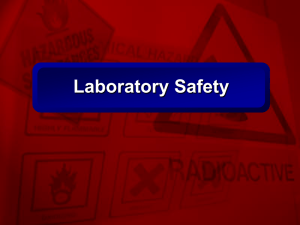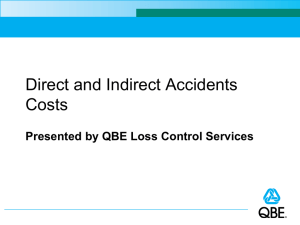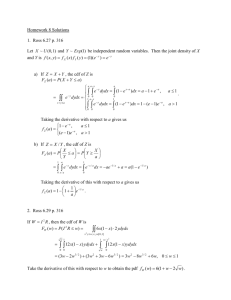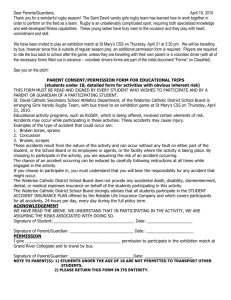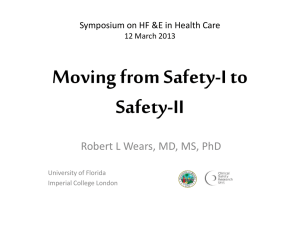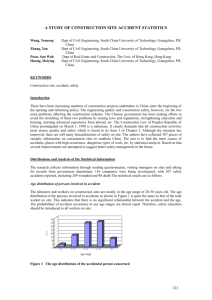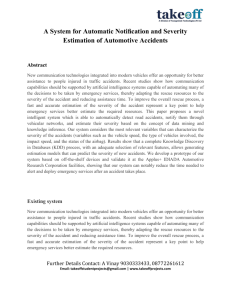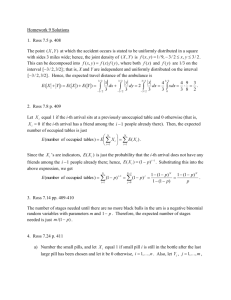Homework 7 Solutions
advertisement
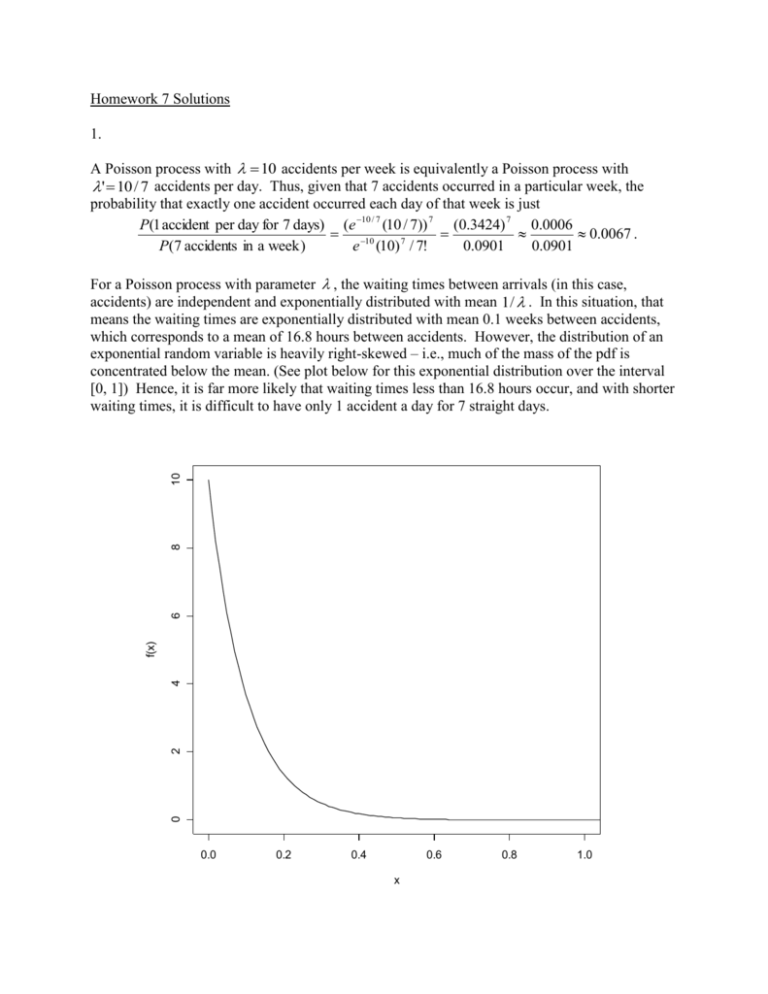
Homework 7 Solutions 1. A Poisson process with 10 accidents per week is equivalently a Poisson process with ' 10 / 7 accidents per day. Thus, given that 7 accidents occurred in a particular week, the probability that exactly one accident occurred each day of that week is just P(1 accident per day for 7 days) (e 10 / 7 (10 / 7)) 7 (0.3424) 7 0.0006 10 0.0067 . P(7 accidents in a week ) 0.0901 0.0901 e (10) 7 / 7! 0 2 4 f(x) 6 8 10 For a Poisson process with parameter , the waiting times between arrivals (in this case, accidents) are independent and exponentially distributed with mean 1/ . In this situation, that means the waiting times are exponentially distributed with mean 0.1 weeks between accidents, which corresponds to a mean of 16.8 hours between accidents. However, the distribution of an exponential random variable is heavily right-skewed – i.e., much of the mass of the pdf is concentrated below the mean. (See plot below for this exponential distribution over the interval [0, 1]) Hence, it is far more likely that waiting times less than 16.8 hours occur, and with shorter waiting times, it is difficult to have only 1 accident a day for 7 straight days. 0.0 0.2 0.4 0.6 x 0.8 1.0 2. Ross 5.37 p. 251 a) If X is uniformly distributed over (-1, 1), then we have 0.5, 1 x 1 f ( x) otherwise 0, Hence, the probability that X 0.5 is P( X 0.5) P( X 0.5) P( X 0.5) 0.25 0.25 0.5 . b) To find the density function of X : F X (a) P( X a) P(a X a) a , where 0 a 1 . Taking the derivative of this with respect to a gives us dF X (a) f X (a) 1 , where 0 a 1 . da In other words, X is uniformly distributed on (0, 1). 3. Ross 5.41 p. 251 We have that is uniformly distributed on ( / 2, / 2) . If R A sin( ) , then to find the distribution of R, we just find the cdf for R as a function of x and then take the derivative with respect to x to obtain the pdf. x FR ( x) P( R x) P( A sin( ) x) P sin( ) A d 1 x x 1 P arcsin arcsin A A 2 / 2 dF ( x) 1 f R ( x) R , where x A dx A2 x 2 arcsin(x / A ) 4. Ross 6.6 p. 313 5 There are a total of 10 different sequences in which the 5 transistors (2 defective) can be 2 drawn from the bin. Each of these sequences is equally likely to occur, so the joint pdf of N1 and N 2 is just 1 P( N1 i, N 2 j ) , i 1, , 4; j 1, , 5 i 10 5. Ross 6.11 p. 314 The customers can be viewed as draws from a multinomial distribution where p1 0.45 is the probability of an “ordinary” purchaser, p2 0.15 is the probability of a “plasma” purchaser, and p3 0.40 is the probability of a browser. Hence, the probability that the store owner sells exactly 2 ordinary sets and 1 plasma set on a day when 5 customers enter his store is just 5! (0.45) 2 (0.15)1 (0.4) 2 0.1458 . 2!1!2! 6. Ross 6.10 p. 314 The joint pdf of X and Y is f ( x, y) e ( x y ) , where x and y are both non-negative real numbers. a) To find the probability that X is less than Y: e P( X Y ) ( x y ) x y 0 y dxdy e ( x y ) 0 0 y e 2 y 1 dxdy (1 e )e dy e 2 0 2 0 y y b) For this part, note that the joint pdf of X and Y can be re-written as f ( x, y) e x e y f X ( x) f Y ( y) ; that is, X and Y are independent. Hence, P( X a) can be obtained by integrating e x and ignoring any mention of y (if X and Y were not independent, we would have to integrate f ( x, y ) over the full range of y and then integrate x over the interval (0, a)): a P( X a) e x dx e x a 0 1 e a . 0 7. Ross 6.14 p. 314 Let X 1 and X 2 denote respectively the locations of the ambulance and the accident at the moment the accident occurs. Then the distance is given by X 1 X 2 , but this is equivalently the range of the two Uniform(0, L) random variables (i.e., X 1 X 2 X ( 2) X (1) ). Using Equation (6.7), we get as the cdf of X1 X F X 1 X 2 (a) P( X 1 X 2 a) P( X ( 2 ) X (1) a ) 2 [ F ( x1 a) F ( x1 )] f ( x1 )dx1 La 2 0 L L x2 a 1 2 2 L x1 1 dx1 2 dx1 2 a( L a) 2 Lx1 1 L L L L 2 La L L La 2 2 L2 ( L a) 2 2 ( aL a ) L ( L a ) 2 L2 L2 2 2 a2 2 aL 2 L a a 2 L L To obtain the pdf, take the derivative of the cdf with respect to a: dF X1 X 2 (a) 2 2a 2 a f X 1 X 2 (a) 2 1 , 0 a L . da L L L L 8. Ross 6.15 p. 314 a) The joint density over the region R must integrate to 1, so we have 1 f ( x, y )dxdy cdxdy cA( R) , ( x , y )R ( x , y )R where A(R) is the area of the region R; hence A( R) 1 / c . b) Since the region R is a square with sides of length 2, A( R ) 4 , and f ( x, y ) 1 / 4 for 1 x 1, 1 y 1 . But this can be re-written as f ( x, y ) f ( x) f ( y ) , where f ( x) 1 / 2, 1 x 1 , and f ( y ) 1 / 2, 1 y 1 . In other words, X and Y are independent uniform random variables on the interval (-1, 1). c) The probability that (X, Y) lies in the circle of radius 1 centered at the origin is just the area of the circle multiplied by 1/4: 1 1 P( X 2 Y 2 1) dxdy A(C ) . 4 4 4 C : x 2 y 2 1
